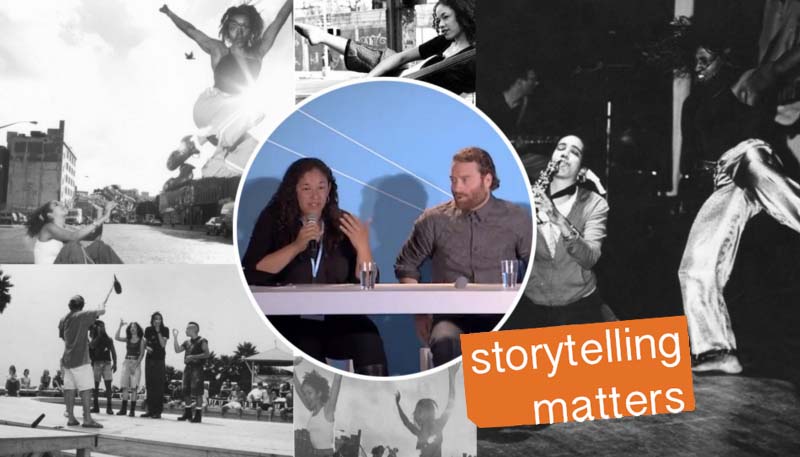A personal journey from analog to digital
November 2nd, 2017 | BY KAMAL SINCLAIR
Reprinted from Immerse News, Immerse.news
A prelude to the Making a New Reality series
In 2008 my life took a turn from the world of live performing arts and tangible visual arts to an increasingly more virtual engagement with arts and creativity. I went from a primarily analog world to a primarily digital one in a period of rapid innovation and fundamental changes to the human communication architecture. This personal journey has informed a long-form research project that I’ve been conducting with support from the Ford Foundation’s JustFilms program and will be publishing in the pages of Immerse over the next several months.
The JustFilm’s commission enabled me to intensively listen to a host of voices answering the questions: How do we provide robust support for those working to further equality through emerging media? and How do we ensure equality in the industries of emerging media?
The progress of racial justice and the development of technologies are not linear. Every time you develop a new technology, you need to have a thought process about the history and system of oppression that the technology is being created, and released, into. Think about ways to bend the technology to justice and not allow it to replicate, entrench, and worsen injustice.
— Joshua Breitbart, Senior Advisor for Broadband at the Office of the Mayor, New York City
Transforming alongside the world
As a long-time cast member of an Off-Broadway show, the owner and artistic director of a dance theater company, a teaching artist, and a strategist for one of the largest traditional art campuses in the country, the transition into the primarily tech-driven environment of emerging media made me feel like Alice falling down the rabbit hole into Wonderland. First, I became a producer and artist on a landmark transmedia art project archived at the Smithsonian, then a producer for the top transmedia production studio in Hollywood, then the director of the New Frontier Lab Programs at the Sundance Institute.
It was a huge adjustment to be the outsider turned insider, and not just because I transitioned from engaging with some of the oldest art forms to some of the newest, but because I have an intersection of identity backgrounds that are not well represented in Silicon Valley, Hollywood, gaming or corporate America (some of the fields that converge in emerging media). As an insider, I’ve noticed a lot of details that seem curious, both in the awesome and fearsome sense of the word. Now, in 2017, I can tell the story of a woman of color, social justice advocate and single mother of three who stands near the epicenter of a media paradigm shift and has a front row seat to the process of power replicating itself.
It has been a cherished and privileged journey, but also a disturbing one that has shaken my core. I’ve been witness to the pitfalls of new technologies born into systems of oppression that caused me to deeply question the possibility that justice and equality could ultimately prevail — though there have also been profound moments where small interventions made a significant impact on furthering inclusion and fair distribution of power.
Furthering equality through media
Over the 80-plus years of its history, the the Ford Foundation has made catalyzing interventions in media, including establishing the framework and seed resources for public television in the United States, and supporting the rise of the independent media field, including the field of independent documentaries. Currently, Ford Foundation’s JustFilms initiative has a robust history of funding moving image media makers and the organizations that support them in seeking to reduce inequality in all of its forms through social justice storytelling. As part of the Creativity and Free Expression Program, JustFilms supports projects, organizations and networks working across film, and increasingly in emerging media, that inspire imaginations, challenge stereotypes, and help transform the conditions that perpetuate injustice.
Seeing the new story technologies emerging and being applied to social justice issues, Cara Mertes, the Director of the JustFilms program, commissioned this global field scan and analysis to identify the kinds of interventions that might tip the scales of emerging media toward justice and equality.
I’ve been witness to the pitfalls of new technologies born into systems of oppression that caused me to deeply question the possibility that justice and equality could ultimately prevail — though there have also been profound moments where small interventions made a significant impact on furthering inclusion and fair distribution of power.
Through a series of eight articles over eight months, Immerse will publish the results of the Making a New Reality research project. Each post will provide a summary of major findings with links to detailed segments of the research. What this research makes clear is that the scale of disruption in creative media making, distribution and moving image storytelling will touch every aspect of the way societies are organized. The goal is to help Ford Foundation, as well as its grantees, peer philanthropy organizations, and the greater community of changemakers better navigate disruption on a scale seen only once a century.
Ultimately, I hope this series will fuel a broad-based and vigorous discussion, as well as informing actionable, critical interventions that can improve equity and inclusion in emerging media and ensure that a broader set of stories are influencing our collective vision of the future. This is our challenge.
Interventions for equity
The thought leaders I interviewed had varying ideas for interventions that, as interviewee Jennifer Arceneaux observed, fall into four focus areas:
Industry — direct interventions in the tech, gaming, film, and bio-media industries
The goal of these interventions is to disrupt the centers of power to ensure that diverse voices are included and represented at every level of these industries.
Strategies include:
- Creating an impact investing fund that would focus on supporting social entrepreneurs from the creative sector, with a special priority for traditionally underrepresented voices.
- Mitigating the wealth gap and high barriers to entry.
- Advocating for funding programs that embed diverse artists into the think tanks and councils forming to design the “rules” for integrating emerging tech and media into our societal infrastructure
Education—interventions focused on educating the citizenry, through the formal education system, professional development programs, and community programs
The goal of these interventions is to disrupt the power imbalance that exists between code-literate and code-illiterate communities, in terms of designing human-centered futures and equitable economic systems.
Strategies include:
- Increasing STEAM curriculum
- Teaching ethical design practices
- Supporting code/tech literacy programs in traditionally oppressed or under-resourced communities.
Public Space and Policy — Interventions focused on circumventing the commercial marketplace by creating a public or noncommercial emerging media ecosystem that can be competitive with for-profit platforms for audience engagement
The goal of these interventions is to develop approaches to media distribution that are decentralized and diverse, while building a brand that can incorporate multiple content types and attract audiences.
Strategies include:
- Building inclusive interdisciplinary communities outside of industry power-centers
- Publicly funding creative workforce development initiatives
- Creating policies that break echo chambers in media
- Maintaining net neutrality protecting privacy
Shifting Attitudes — interventions into the consciousness of people through strategies that mitigate bias.
The goal of these interventions is to encourage equality by helping people learn to mitigate their own negative biases about others and themselves.
Strategies include:
- Advocating for creating safe spaces
- Adjusting the center of design — building media infrastructure and tech innovation that centers the imaginations and value systems of traditionally marginalized people
- Breaking the innovator stereotype by amplifying diverse innovators
- Disrupting dependency narratives and rigid bias narratives
- Expanding identity literacy
- Bridging the gaps between art, science and technology cultures
Developing solutions in dialogue with you
Forthcoming posts in the Making a New Reality series will include :
- November 2017: The high stakes of limited inclusion
Support Articles: Defining emerging media, Zeitgeist of emerging Media, Categories of emerging media - December 2017: Bias in emerging media
Support Articles: Bias narratives, The innovator stereotype, Participation and representation gaps, Pitfalls of the meritocracy or pipeline arguments, Perpetuating patronizing attitudes, Appropriation and co-opting, Biased education system, Diversity stigma - January 2018: Strategies to mitigate bias
Support Articles: Amplification strategy, Lowering barriers to entry and developing new pipelines, Remove priority conflicts, Lean In strategy, Identity literacy, Disrupt dependency and rigid bias narratives, Explicit and implicit inclusion programs, Adjust the center of design - February 2018: — Silos of knowledge and discipline
Support Articles: Biased algorithms and the false sense of democratization, Consolidated media landscape, Navigating disruption - March 2018: — Bridging the gaps in disciplines
Support Articles: Entrepreneurship, Sustainability and investment parity; Bridge art, science, policy and technology; Break down silos; Strategically embedding artists in notable research centers, think tanks, and summits; Build interdisciplinary community outside power centers; Invest in hybrid talent; Advocate for creative workforce development - April 2018: Boundary issues
Support Articles: Ethical boundaries, Cybersecurity, Privacy and regulation, Lack of safe spaces, Tensions between social good vs. corporate good - May 2018: Ethics & Policy
Support Articles: Establish ethical design practices, Break the echo chamber, Educate the citizenry, Invest in public or noncommercial platforms, Collaborative design, Advocate for media and tech to take responsibility, Advocate for strategic policies and regulations, Evaluation structures - June 2018: A Framework for Action
Support Articles: Outcomes from discussions at “equality in emerging media” convenings, Pilot program, Contributors list
This is not meant to be a definitive or comprehensive set of documents on equality in emerging media. It is meant to be a catalyst for collaborative reflection and discourse that may help us resolve the issues raised. Each article invites responses from the field so that we might mitigate blind spots and find effective strategies for achieving equality and justice in emerging media.
We look forward to finding out how your own experiences have given you inspiration.



Leave a Reply